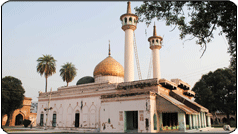Karbala of Dayanat-ud-Daulah
Situated near Rauza Kazmain, the monument known as Karbala Dayanat-ud-Daulah is well-known. It was built by Dayanat-ud-Daulah, a khwajasara (eunuch) of King Wajid AN Shah and incharge of his Pari Khana-the centre of music, dance and drama at Qaiser Bagh that functioned during the days when Wajid Ali was the heir apparent. The khwajasara was earlier named Mohammed Ali Khan but when the title Dayanat-ud-Daulah was conferred upon him he came to be known as Muatamad Ali Khan (Muatamad means trustworthy). He had built the Karbala as his burial place.
The Karbala became the cynosure of all eyes in May 1854, when a unique zarih (model of the mausoleum of Imam Hussain at Karbala), specially made of khak-e-shifa (clay, believed to have curative properties, unearthed from the mausoleum of Imam Hussain) was brought back by one Mehdi Hasan, on his return from Karbala, where he had stayed for twenty years. It was reverently placed at Karbala of Dayanat-ud-Daulah and King Wajid Ali Shah with his nobles and officials, all dressed in black (signifying mourning for the martyrdom of Imam Hussain) arrived in a regal procession that wound its way through the narrow lanes of the city, to pay their respects to this revered zarih.
The Karbala with its gilded dome is also a treasure-house of excellent Arabic calligraphy which appears in the form of verses of the Holy Quran and qualifying titles attributed to the Almighty. The borders on the entrance and top of the walls on all four sides, vertical and horizontal panellings in the verandah and the soffit of the dome, are resplendent with calligraphic specimens. Such calligraphy in the form of Quranic verses was repeated on the gateways and cloisters but these have since been obliterated by the thick coating of lime and plaster during repairs. The interiors abound with delicate floral patterns and florid arabesque.
However, a brilliant artistic example of excellent master craftsmanship is there in the building as beautiful coloured glass and glittering mirror work on the two wooden pillars in the portico and also on the verandah in a very dilapidated state.
Source:
Hindustan Times, City Scan, A Time in History
Wednesday 3.6.1998 — Dayanat-ud-Daulah

